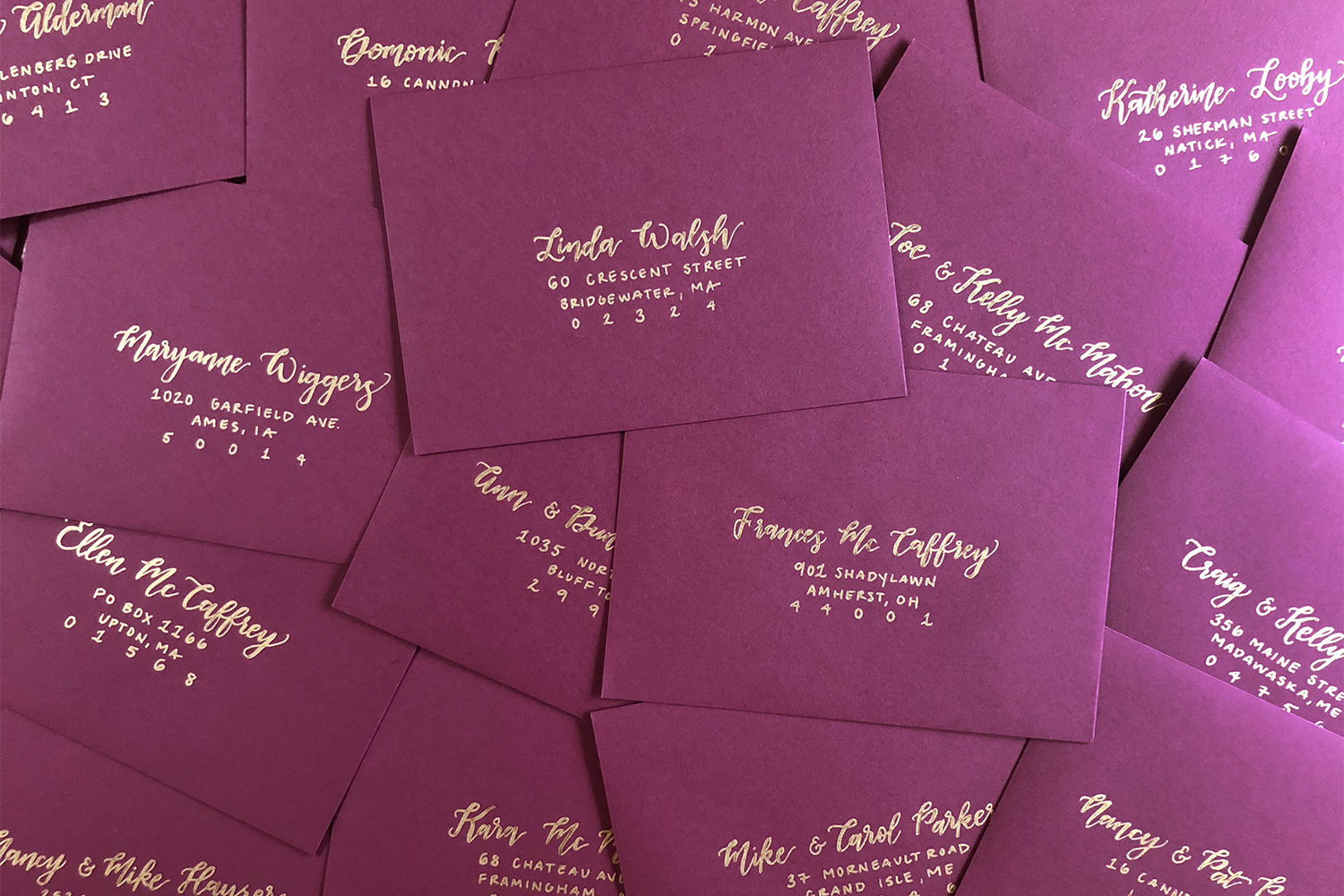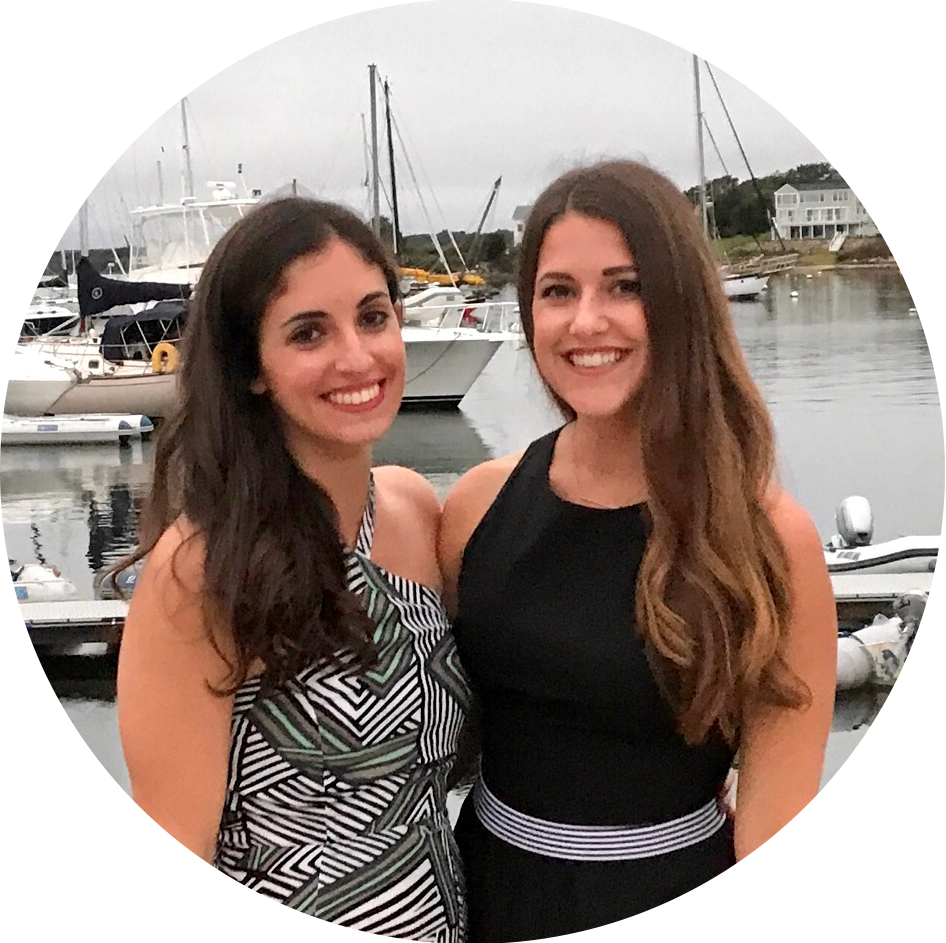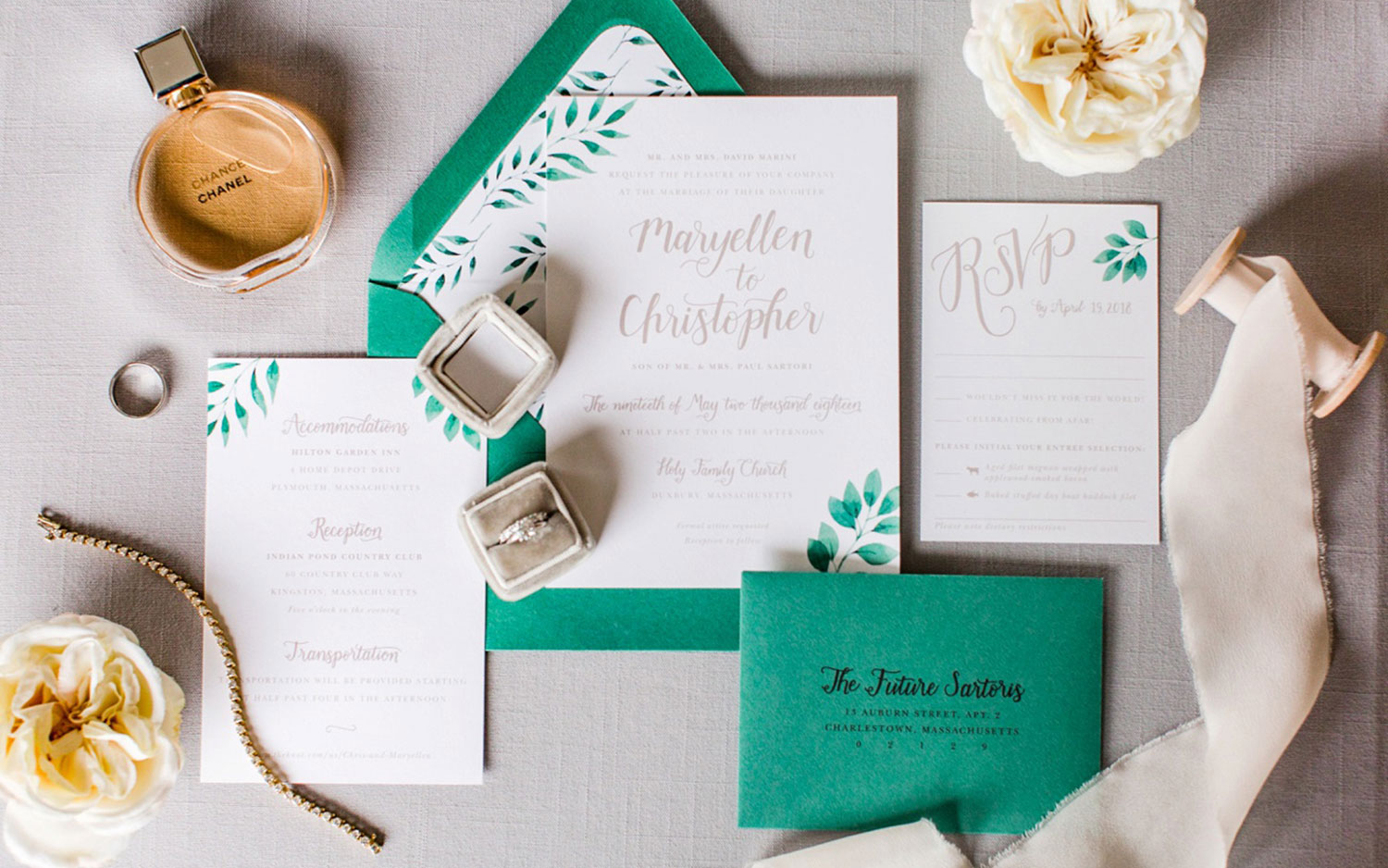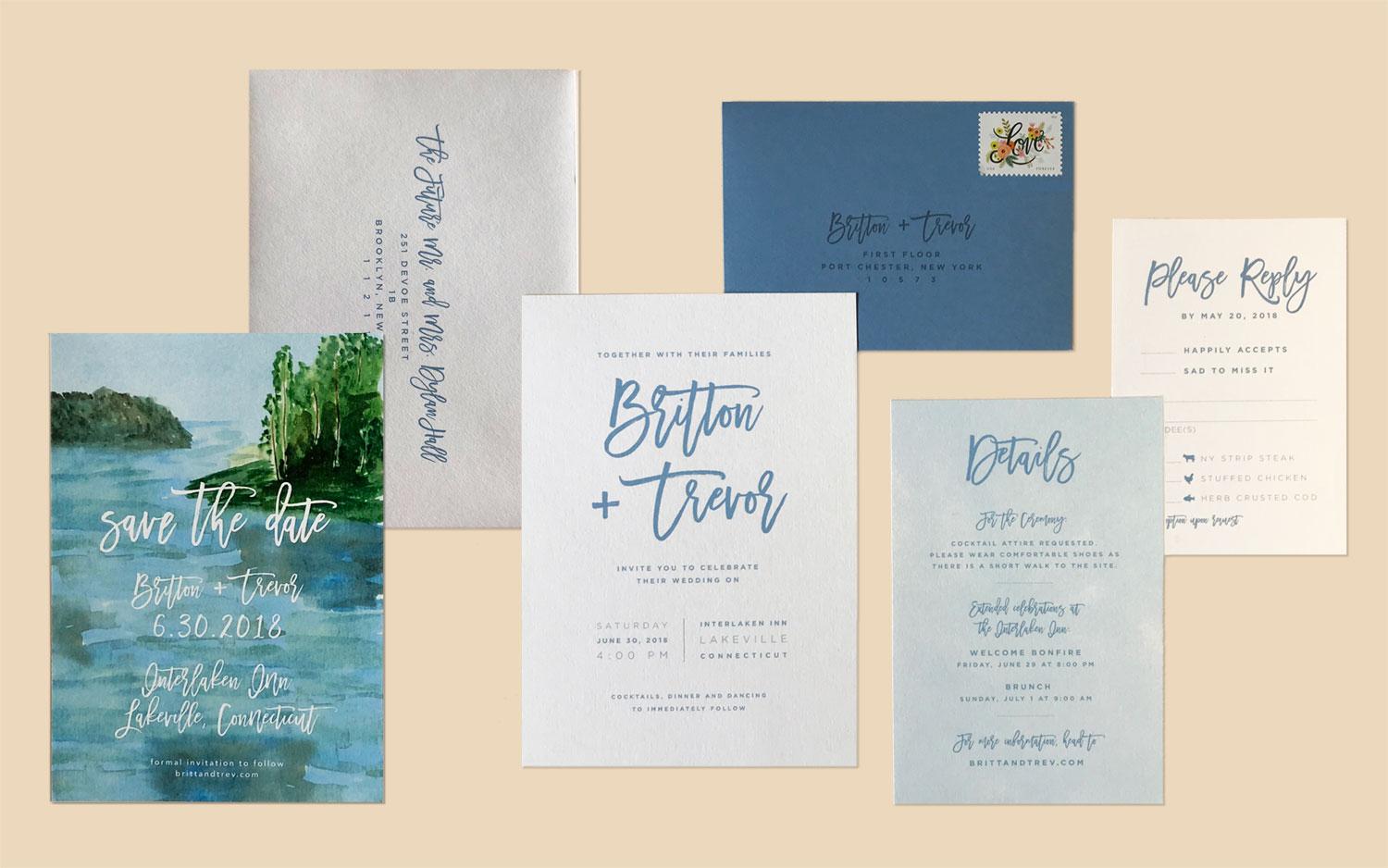How To Address Your Wedding Envelopes
How To Address Your Wedding Envelopes
Whether you’re addressing your envelopes yourself, or hiring a calligrapher (like us!), determining the proper way to address your envelopes can seem overwhelming. Yes, there is proper etiquette as to how you should address your wedding envelopes. But don’t worry, we’re here to help.


Your envelopes are the first thing your guests will see as part of your invitation suite, and therefore should be both beautiful and clear. You may have questions such as, which person should be listed first on the envelope? Or, what if I’d like single guests to have plus-ones?
There are really just a few things you need to know that will help ensure your envelopes follow proper etiquette. And if you think common etiquette doesn’t matter, remember that the way a guest’s envelope is addressed is the signal to them about who is invited. Writing “Mr. John Smith” means that only he is invited to the wedding, while “Mr. John Smith and Guest” means that he is able to bring a plus-one. But the most important thing to remember with envelope addressing is that it should be consistent throughout, and should speak to the tone of your wedding.
As a note, very formal wedding invitation suites come with both inner and outer envelopes. The outer envelope almost always uses titles and is more formal, while the inner envelope is more informal, often leaving out titles and last names. We’ve found that most of our clients prefer only one envelope and we’ve written these guidelines as such. Additionally, formal etiquette states that abbreviations other than titles should not be used (meaning states and street extensions are written out and ampersands are never used) but we find this a bit restrictive, and tell clients that as long as abbreviations are consistent with the return address and the invitation, they are perfectly acceptable.

Names
If you’re having a traditional wedding, using titles (like “Mr.” and “Mrs.”) is expected. For ladies, “Mrs.” is reserved for married women, “Miss” is for unmarried women, and “Ms.” can be used for either (though often unmarried women over a certain age find “Miss” too youthful and prefer “Ms.”). For any female guest where the marital status is unknown, “Ms.” should be used. Excluding titles typically would denote a more informal gathering, but we’re seeing a trend with couples getting really creative and personal with addressing. Here are a few different ways you may choose to have your names read:
- Mr. John & Mrs. Michelle Smith
- Mr. & Mrs. John Smith
- Mr. & Mrs. Smith
- John & Michelle Smith
- John & Michelle
See? You never thought about how many ways there are to write a set of names! Think about the tone of your event to determine which style makes most sense for your envelopes. A backyard wedding may be better with first names only, while a black tie event might speak more towards full names with titles. But again, this is up to what you think is best!
Additionally, you may have a preference on using “and” or “&”. Traditionally, “and” is written out instead of the abbreviated version which is an ampersand “&”. However, we think an ampersand is a great design element, especially on hand lettered envelopes, and we’re all for them. Again, the key here is to choose which format you like, and then to keep it consistent for every envelope.

Different Name Types
Not every one of your guest envelopes will include the names of a married couple. So what happens with the other variations? Again, consistency is key here, so if you’ve decided to use full names and titles, keep that going with every name variation you encounter.
Couple with different last names
For a married couple, list the male first. For unmarried or same-sex couples, list the person you are closest with first.
- Mr. John Smith & Mrs. Michelle Jones (married)
- Ms. Michelle Jones & Mr. John Smith (unmarried)
- Mr. Smith & Ms. Jones
- John Smith & Michelle Jones
- John & Michelle
Engaged couple
It can be fun for soon-to-be-married couples to receive mail with their future name written. But be aware that some couples may love this while others could be offended (especially if they aren’t planning to change their name), so we only recommend this for people you’re close with.
- The Future Mr. & Mrs. John Smith
- Mr. John Smith & Miss Michelle Jones

Families and children
If you’re inviting children to your wedding, they should be listed on the envelope underneath the parents’ names. Writing “family” also says that they are invited. Not including the children on the envelope tells guests that their children are not invited.
- The Smith Family
- Mr & Mrs. Smith & Family
- Mr. & Mrs. John Smith
Sarah, Andrew, & Peter
Single guests
A name listed on its own signals that the guest should be coming on their own. If you’re giving them a plus-one, include the words “& Guest”.
- Ms. Michelle Jones (& Guest)
- Ms. Jones (& Guest)
- Michelle (& Guest)
Distinguished titles
The guest with the highest ranking distinguished title (such as Doctor, Captain, Honorable, Judge) should be listed first in a couple. Two of the same distinguished title may be pluralized.
- Dr. Michelle & Mr. John Smith
- The Honorable Michelle Jones & Mr. John Smith
- Judge Smith & Lieutenant Smith
- Doctors John & Michelle Smith
- The Captains Smith


Address
The name portion of the envelope is definitely the trickiest to navigate, but don’t forget about the actual address portion! It is formal etiquette to not abbreviate anything on envelopes (aside from titles like Mr., Mrs. etc.), which means that street extensions (Road, Avenue, Street) and state names should be spelled out. However, in breaking with tradition and perhaps modernizing envelope addressing a bit, we like to defer to our clients on this. We think it’s okay to write “NY” instead of “New York” so long as it’s consistent with the return address and what’s written on the actual invitation itself.

Return Address
Your return address can go either on the back flap or the front upper left corner of the envelope. We typically prefer the back flap so the guest’s address stands out on the envelope front, especially if it’s hand lettered. We offer both printing and hand lettering services for return addresses. Another option is ordering a custom address stamp. They come in many different style options, don’t cost too much, and will come in handy with all the wedding-related mail you will be sending. No matter what you choose, just make sure the format of your return address is consistent with your guests’ addresses!

Other Notes
While this is your wedding, please note that more informal addressing (with no titles) might be seen as disrespectful to older and more conservative guests. Take into account the vibe of your big day, along with your invitees, and use your best judgement to determine what makes most sense for you.
Although it should be clear through your envelope addressing who exactly is invited to your wedding, some guests do still mistakenly assume their plus-one or children are welcome. If this is a concern for you, we recommend adding some explanatory information on your wedding website. But you may also need to follow up with guests personally to explain the situation.
If you have any other questions about envelope addressing, or would like to hire us for your own envelopes, please contact us – we’d love to help!

























